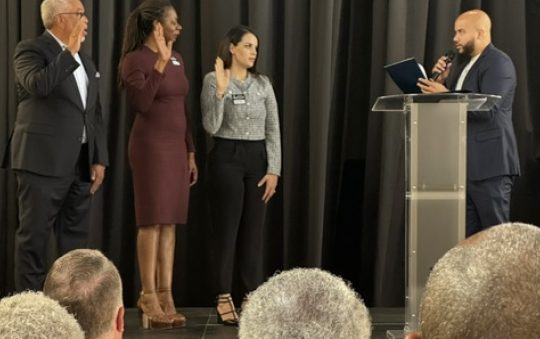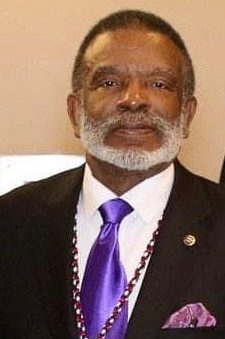Legends
DR. MARK DEAN
Dr. Dean, the Scholar
Dr. Dean, IBM’s Man
Dr. Mark Dean
“The dean of Black Inventors referred to as America’s high-tech Invisible Man”
In the book, Invisible Man, the main character is a Black man referred to as socially invisible and Dr. Mark Dean has been referred to as America’s high-tech invisible man; and he too is a Black man. It appears that though the world has advanced in technology–a high-tech world–Dr. Dean’s accomplishments have remained largely unattached from him, as the inventor, by mainstream society even as some of his inventions are as commonplace as the television, refrigerator and telephone. He has over 30 patents; is the architect of the modern-day personal computer; and holds three of the original nine patents on the computer that all personal computers (PC)s are based upon.
That Dr. Dean’s name is not a household item is not surprising or remarkable because many of life’s basic inventors go unnoticed by the society that depend on their work to exist effectively. The PC has become an important tool in every aspect of daily life throughout the world and almost everything in people’s daily lives has been affected and/or dependent on his work. Dr. Dean is a computer scientist, computer engineer, computer designer and technology wizard all wrapped up in one human brain.
His father’s skills as a supervisor at the Tennessee Valley Authority (TVA) obviously rubbed off on Dean; as father and son, they both built a tractor from scratch. Born in Jefferson City, Tennessee in March 1957, he excelled in math as a young student in elementary school. He was one of the few Black students at Jefferson City (Tenn.) High School, where he was both a star athlete and a straight-A student. He added to his elementary school regimen and took advanced level math courses. Dean built his own computer, radio, and amplifier, and continued his interests in electrical gadgetry prior to obtaining a Bachelor’s degree in Electrical Engineering from the University of Tennessee in 1979 as part of the university’s Minority Engineering Program.
 As a normal part of life in the South, Dean encountered obstacles about race. The fact that despite his accomplishments, he has been referred to as America’s high-tech invisible man, may be a statement that race still serves as a barrier of social acceptability irrespective of individual accomplishments. Like many accomplished Blacks, Dean can still recall instances where his race trumped his academic achievements. As a straight A-student and light skinned, he recalled one white friend in sixth grade asked him if he was really Black because as Dean concluded his friend had believed that he was too smart to be Black. Furthermore, as he advanced academically, Dean said, “That was the problem–the assumption about what Blacks could do was tilted.” (Later on, he experienced the same bias as a computer scientist at IBM and realized that high achievements do not dull the stigma of institutional racism in corporate America).
He went on to Florida Atlantic University where he earned a Masters degree in Electrical Engineering in 1982. Dean joined IBM in 1980; along with a colleague he developed the interior architecture (ISA systems bus) as a part of the IBM PC project in 1981. It enabled numerous devices to be connected to the PC such as printers, modems, machines, etc. and it was synchronous with the central processing unit (CPU) clock, until sophisticated buffering methods were developed and implemented by chipsets to interface ISA to much faster CPUs. Dean also invented major computer circuits/processor chips.
The next step in his upward thrust was a doctorate degree in Electrical Engineering. Dean had already been a seasoned player at IBM and had been out of school for 10 years when he enrolled at Stanford University, California where he earned his Ph.D. in 1992. He had become one of the most prominent inventors–Black or White–in the field of computers.
After Dr. Dean earned his Ph.D., he continued his work at IBM and in 1995, he was named an IBM Fellow, one of only 50 active fellows of IBM’s 200,000 employees becoming the first African American to be honored with IBM Fellowship. Two years later Dean was Vice President of Performance for IBM-RS/6000 Division and, along with his colleague Dennis Moeller, with whom he had developed the ISA system, Dr. Dean was inducted into the National Inventors Hall of Fame. That honor has been bestowed on less than 150 members and their system has permitted the PC to become an integral part of everyday life in society.
As one of IBM’s “idea men,” Dr. Dean has helped to make instrumental changes in areas ranging from the research and application of systems technology circuits to operating environments. As director of IBM’s research lab in Austin, Texas in 1999, he led the team that built a gigahertz chip which did a billion calculations per second. Not only is he a team player, he often works independently on a host of pet projects, including the “electronic tablet.” In addition, besides being a computer scientist, he is also an executive, part of IBM’s management team.
There has been a trend to restructure the dissemination of news in the printed media (newspapers, books, magazines, flyers, etc.) and Dr. Dean came up with the idea for a rugged, magazine-sized device that could download any electronic text, from newspapers to books. The device he “saw” was analogous to a DVD player, radio, wireless telephone and provided access to the Internet. As presently implemented, that idea was a fore-runner of today’s screen texting and voice-activated mechanisms and even talk back. Dr. Dean visualized that while the device could possibly accomplish all of those things, it was important to produce it inexpensively enough so that every student could get one in lieu of books and other printed materials, and publications could give one to every person who buys a subscription. As far out as the device is concerned, Dr. Dean believed that it could be available soon. “We are almost there. The only technology left to conquer is the display, we have the other pieces,” Dr. Dean said. “We will see it pretty soon — easily within 10 years.”
With the rapid advancement of technology, it’s not just “pretty soon” as Dr. Dean said, it’s a good probability because he also concluded, “if you can talk about it that means it’s possible.” And with an understanding of the possibilities that are out there in the young minds, despite distractions, obstacles, barriers and resistance–especially for young Black minds–he further commented, “A lot of kids growing up today aren’t told that you can be whatever you want to be; there may be obstacles, but there are no limits.”
 When he was a graduate student Dr. Dean engaged in prudent research and as a professional (computer scientist), he is in a position to pioneer a path for young students interested in careers in technology. How his work impacts the daily lives of so many is a testament to the vitality of Dr. Dean’s inventions. It is not necessarily what has been accomplished so far today but the results of Dr. Dean’s inventions would allow technology to advance in perpetuity. As he explained that when he arrived at Stanford University, his knowledge of transistors and circuits was limited, but that environment exposed Dr. Dean to custom circuits design, transistors and silicon processes. The future of development approaches and processes however did allow him to increase his existing knowledge of logic design, architectures, bus interfaces and computer protocol, and also to be able to build things at the transistor level.
 In addition to being the first African American to receive an IBM Fellowship, the highest level of technical excellence at the company, Dr. Dean was inducted into the National Inventors Hall of Fame in 1997. Though he is listed as an IBM vice president overseeing the company’s Almaden Research Center (ARC) in San Jose, California, in researching its website for information on Dr. Dean, there was a “whiteout” when his name was clicked–reinforcing the invisible man syndrome. After three decades at IBM, there still seem to be difficulties in researching Dr. Dean’s name and accomplishments on the IBM Almaden site. Why? Is it an accident or merely an oversight; and what is the Almaden Research Center?
 According to the IBM website where Dr. Dean is/was listed as its vice president, “The Computer Science group at IBM Research–Almaden (ARC) leads the next generation of research in database management, intelligent information systems, user productivity, healthcare IT (Information Technology) and the theoretical foundations of computer science.” In describing the work at the center where Dr. Dean is one of the researchers, the method of writing in the first person (“we,” “our,” etc.), suggests an atmosphere of comradeship, brotherhood and sisterhood among the scientists/researchers–a close-knit family.
 It continued thus, “We invent new algorithms and architectures for finding, integrating, managing, analyzing and protecting information, and explore and prototype new modes of user interaction. We are creating the technical underpinnings for a national healthcare network and do fundamental research into game theory and mechanism design, lattices and the theory of semantic mappings. Our innovations have played a role in creating entirely new disciplines such as relational database management and have also led to novel research areas such as information mining, schema mapping, data disclosure management, and activity management.” With that kind of academic/scientific/computer research background, Dr. Dean is clearly one of today’s great inventors, and not specifically Black inventors, but inventors period, who just happen to be a Black man.
 During an interview in 2002, Dr. Dean said, “The PC, even though it was a great achievement, there ‘s still a long way to go to make it easy to use.” Since then there have been major strides by leaps and bounds to make his vision a reality. The PC now is as fundamental to people’s daily lives as the telephone, the automobile and the refrigerator. As a matter of fact, thanks to Dr. Dean most of the aforementioned have computerized systems to make them work more efficiently.
 Despite the successes of his inventions, it is amazing that when IBM celebrated the 20th anniversary of the personal computer, there wasn’t a single word about Dr. Dean. Furthermore given the prevalence of the mass media pressures about negative, stereotypical portrayals of African Americans on television, print and elsewhere, it seemed a sure thing that Dr. Dean’s historic achievements would not be overlooked; but they were.
 History written by others has always been cruel when it came to providing correct information about African Americans and their achievements on the stage of human history. Dr. Dean is a perfect example walking in the footsteps of other great Black inventors including John Stanard, inventor of the refrigerator, George Sampson, creator of the clothes dryer,
Alexander Miles and his elevator, Lewis Latimer and the electric lamp.
 All of these inventors share two things: (1) they changed the landscape of society; and (2) society relegated them to the footnotes of history. Hopefully, Dr. Mark Dean would not go away as quietly as they did, for he help started the Digital Revolution that created millions of jobs in information technology.
 Dr. Dean still has a lot of inventing left in him at the young age of 53.








